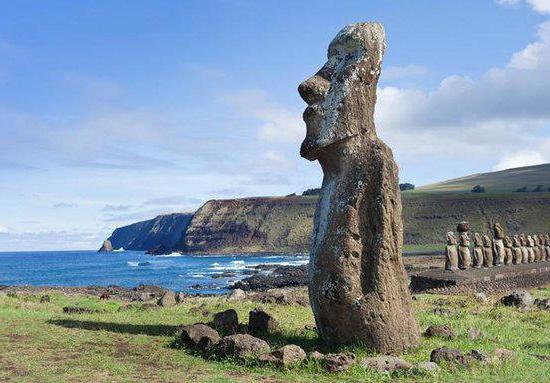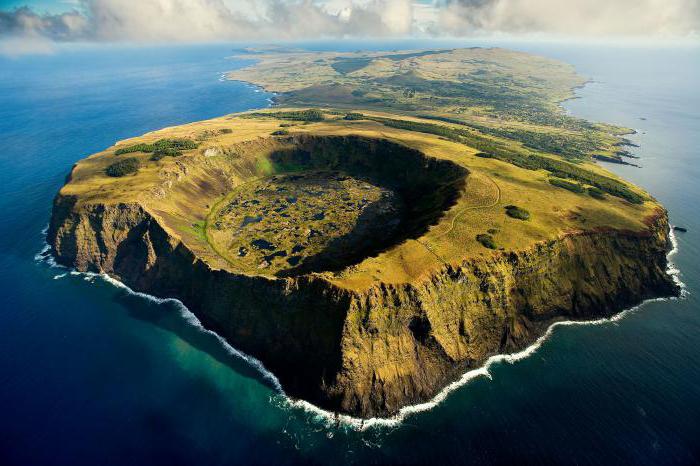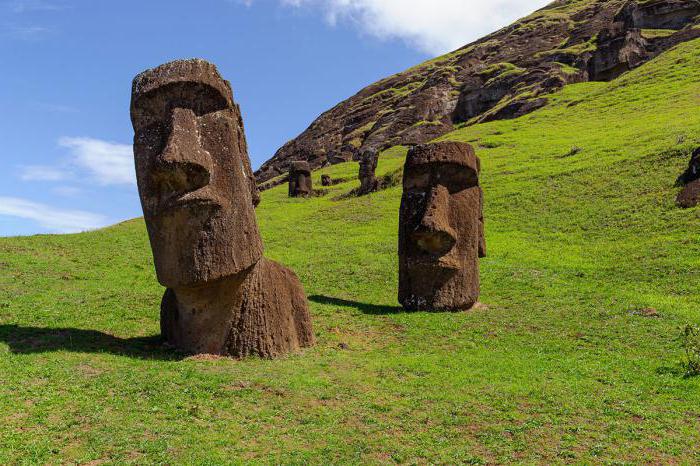Easter Island is the most remote inhabited landmass in the world. Its area is only 165.6 square kilometers. Belongs to the island of Chile. But to the nearest mainland city of this country, Valparaiso, 3703 kilometers. And there are no other islands nearby, in the eastern part of the Pacific Ocean. The nearest inhabited land is located in 1819 kilometers. This is Pitcairn Island. He is known for having wanted to stay on the rebellious crew of the Bounty ship. Lost in the vastness of the Pacific Ocean, Easter Island holds many secrets. Firstly, it is not clear where the first people came from. They could not explain anything to Europeans about this. But the most mysterious mysteries of Easter Island are its stone idols. They are installed along the entire coastline. The natives called them the Moai, but they could not clearly explain who they were. In this article, we tried to summarize the results of all recent scientific discoveries in order to unravel the secrets that enveloped the most remote land area from civilization.

Easter Island History
On April 5, 1722, sailors of a squadron of three ships under the command of the Dutch navigator Jacob Roggeven saw land on the horizon, which had not yet been marked on the map. When they approached the east coast of the island, they saw that it was inhabited. The natives sailed to them, and their ethnic composition impressed the Dutch. Among them were Caucasians, Negroids and representatives of the Polynesian race. The Dutch were immediately struck by the primitiveness of the technical equipment of the islanders. Their boats were riveted from pieces of wood and let the water pass in such a way that half the people in the boat scooped it out, and the rest rowed. The landscape of the island was more than dull. Not a single tree towered on it - only rare bushes. Roggeven wrote in his diary: "The desolate appearance of the island and the exhaustion of the natives suggest the barren land and extreme poverty." But most of all the captain was shocked by stone idols. How, with such a primitive civilization and scarce resources, did the natives have the strength to carve out so many heavy statues from stone and bring ashore? The captain did not have an answer to this question. Since the island was discovered on the day of the Resurrection of Christ, it received the name Easter. But the natives themselves called him Rapa Nui.

Where did the first inhabitants of Easter Island come from
This is the first mystery. Now on an island with a length of 24 kilometers live more than five thousand people. But when the first Europeans landed, there were much fewer natives. And in 1774, the explorer Cook counted only seven hundred islanders on the island who were emancipated from hunger. But at the same time among the natives were representatives of all three human races. Many theories have been put forward about the origin of the Rapa Nui population: Egyptian, Mesoamerican and even completely mythical, that the islanders are survivors of the collapse of Atlantis. But modern DNA analysis shows that the first Rapanui landed around the year 400 and arrived, most likely, from Eastern Polynesia. This is evidenced by their language, which is close to the dialects of the inhabitants of the Marquesas and Hawaiian Islands.
The development and decline of civilization
The first thing that caught the eye of the discoverers was the stone idols of Easter Island. But the earliest sculpture dates back to 1250, and the latest (unfinished, remaining in a quarry) - to the 1500th. It is not clear how the natives' civilization developed from the fifth to the thirteenth century. Perhaps, at a certain stage, the islanders moved from clan-tribal society to clan military alliances. Legends (very controversial and fragmentary) tell of the leader Hotu Matu'a, who first set foot on Rapa Nui and brought with him all the inhabitants. He had six sons who divided the island after his death. Thus, the clans began to have their ancestor, the statue of which they tried to make larger, more massive and more representative than that of a neighboring tribe. But what was the reason that in the beginning of the sixteenth century the Rapa Nujans stopped carving and erecting their monuments? This was discovered only by modern research. And this story can be instructive for all of humanity.

Small scale environmental disaster
Let us leave aside the idols of Easter Island. They were sculpted by the distant ancestors of those wild natives whom the expeditions of Roggeven and Cook found. But what influenced the decline of a once rich civilization? After all, the ancient Rapa Nui were even writing. By the way, the texts of the found tablets are still not decrypted. Scientists have only recently answered what happened to this civilization. Her death was not quick due to the eruption of the volcano, as Cook suggested. She has been agonized for centuries. Modern studies of soil layers have shown that once the island was covered with lush vegetation. Forests abounded with game. The ancient Rapa Nui cultivated agriculture, growing yams, taro, sugarcane, sweet potato and bananas. They went to sea in good boats made from a hollowed palm trunk and hunted for dolphins. The fact that the ancient islanders ate well is indicated by DNA analysis of food found on pottery shards. And this idyll was destroyed by the people themselves. Forests were gradually cut down. The islanders were left without their fleet, and therefore without the meat of ocean fish and dolphins. They have already eaten all the animals and birds. The only food of the Rapa Nui remained crabs and mollusks, which they collected in shallow water.

Easter Island: Moai Statues
The natives could not really say anything about how they were made and, most importantly, how stone idols weighing several tons were brought ashore. They called them "moai" and believed that they contained "mana" - the spirit of the ancestors of a particular clan. The more idols, the greater the concentration of supernatural power. And this leads to the prosperity of the clan. Therefore, when in 1875 the French took out one of the moai statues of Easter Island to deliver it to the Paris Museum, the Rapa Nui had to be restrained with weapons. But, as studies have shown, about 55% of all idols were not transported to special platforms - “akhu”, but remained standing (many in the initial processing stage) in a quarry on the slope of Rano Raraku volcano.
Art style
In total there are more than 900 sculptures on the island. They are classified by scientists chronologically and by style. The early period is characterized by stone heads without a body, with a face turned upwards, as well as pillars, where the torso is very stylized. But there are exceptions. So, a very realistic figure of a kneeling moai was found. But she remained standing in the ancient quarry. In the Middle Ages, the idols of Easter Island became giants. Most likely, the clans competed with each other, trying to show that their mana is more powerful. Artistic decoration in the Middle Period is more sophisticated. The bodies of the idols are covered with carvings depicting clothes and wings, and on the moai’s head huge cylindrical caps of red tuff are often hoisted.
Transportation
No less a mystery than the idols of Easter Island, remained the secret of their movement on the platform "akhu". The natives claimed that the Moai themselves came there. The truth turned out to be more prosaic. In the lowest (more ancient) layers of soil, scientists have discovered the remains of an endemic tree, which is akin to a wine palm. It grew to 26 meters, and its smooth trunks without branches reached a diameter of 1.8 m. The tree served as an excellent material for rolling sculptures from quarries to the shore, where they were mounted on platforms. To hoist idols, we used ropes that weaved from the bast of the Hauchau tree. The ecological disaster also explains the fact why more than half of the sculptures were “stuck” in the quarries.
Short-eared and long-eared
The modern inhabitants of Rapa Nui no longer have a religious reverence for the Moai, but consider them their cultural heritage. In the mid-1950s, explorer Thor Heyerdahl discovered the secret of who created the idols of Easter Island. He noted that Rapa Nui is inhabited by two types of tribes. One earlobe has been lengthened since childhood by wearing heavy jewelry. The leader of this clan, Pedro Atana, told Tur Heyrdal that in their family the ancestors passed on to their descendants the art of creating moai status and transporting them to the installation site. This craft was kept secret from the "short-eared" and transmitted orally. At the request of Heyerdahl Atan, with numerous assistants from his clan, he carved a 12-ton statue in a quarry and in an upright position brought it to the platform.